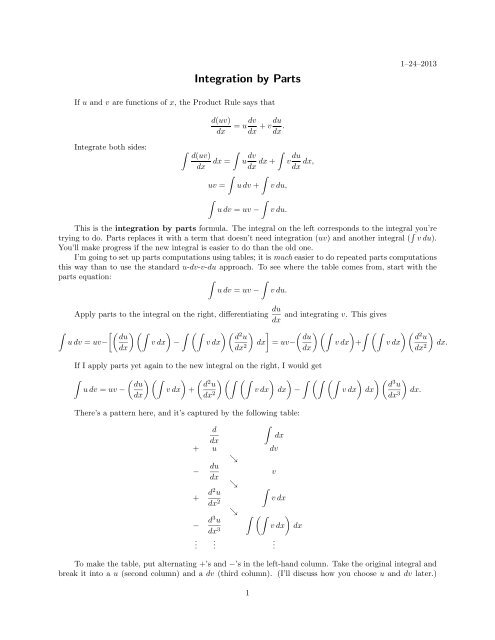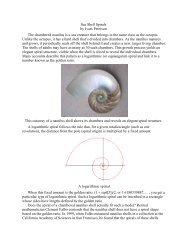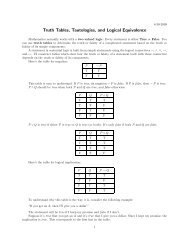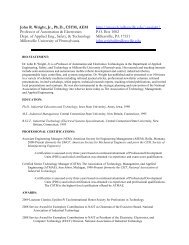Integration by Parts
Integration by Parts
Integration by Parts
You also want an ePaper? Increase the reach of your titles
YUMPU automatically turns print PDFs into web optimized ePapers that Google loves.
<strong>Integration</strong> <strong>by</strong> <strong>Parts</strong><br />
If u and v are functions of x, the Product Rule says that<br />
d(uv)<br />
dx<br />
= udv<br />
dx +vdu<br />
dx .<br />
Integrate both sides: <br />
d(uv)<br />
dx = u<br />
dx dv<br />
dx dx+<br />
<br />
v du<br />
dx dx,<br />
<br />
uv = udv + vdu,<br />
<br />
<br />
udv = uv −<br />
vdu.<br />
1–24–2013<br />
This is the integration <strong>by</strong> parts formula. The integral on the left corresponds to the integral you’re<br />
trying to do. <strong>Parts</strong> replaces it with a term that doesn’t need integration (uv) and another integral ( vdu).<br />
You’ll make progress if the new integral is easier to do than the old one.<br />
I’m going to set up parts computations using tables; it is much easier to do repeated parts computations<br />
this way than to use the standard u-dv-v-du approach. To see where the table comes from, start with the<br />
parts equation: <br />
<br />
udv = uv −<br />
Apply parts to the integral on the right, differentiating du<br />
and integrating v. This gives<br />
dx<br />
2 du<br />
d u<br />
udv = uv− vdx − vdx<br />
dx<br />
dx2 2 du<br />
d u<br />
dx = uv− vdx + vdx<br />
dx<br />
dx2 <br />
dx.<br />
vdu.<br />
If I apply parts yet again to the new integral on the right, I would get<br />
<br />
udv = uv −<br />
<br />
du<br />
dx<br />
<br />
vdx +<br />
2 d u<br />
dx2 <br />
<br />
vdx dx −<br />
There’s a pattern here, and it’s captured <strong>by</strong> the following table:<br />
+<br />
d<br />
dx<br />
u<br />
<br />
dx<br />
dv<br />
ց<br />
− du<br />
dx<br />
+<br />
ց<br />
v<br />
d2u dx2 −<br />
ց<br />
<br />
vdx<br />
d3u dx3 <br />
vdx dx<br />
.<br />
.<br />
.<br />
.<br />
.<br />
.<br />
3 d u<br />
vdx dx<br />
dx3 <br />
dx.<br />
To make the table, put alternating +’s and −’s in the left-hand column. Take the original integral and<br />
break it into a u (second column) and a dv (third column). (I’ll discuss how you choose u and dv later.)<br />
1
Differentiate repeatedly down the u-column, and integrate repeatedly down the dv-column. (You don’t write<br />
down the dx; it’s kind of implicitly there in the third column, since you’re integrating.)<br />
How do you get from the table to the messy equation above? Consider the first term on the right: uv.<br />
You get that from the table <strong>by</strong> taking the + sign, taking the u next to it, and then moving “southeast” to<br />
grab the v.<br />
If you compare the table with the equation, you’ll see that you get the rest of the terms on the right<br />
side <strong>by</strong> multiplying terms in the table according to the same pattern:<br />
(+ or −) → (junk)<br />
ց<br />
(stuff)<br />
The table continues downward indefinitely, so how do you stop? If you look at the last messy equation<br />
above and compare it to the table, you can see how to stop: Just integrate all the terms the last row of the<br />
table.<br />
A formal proof that the table represents the algebra can be given using mathematical induction.<br />
You’ll see that in many examples, the process will stop naturally when the derivative column entries<br />
become 0.<br />
<br />
Example. Compute<br />
x 3 e 2x dx.<br />
<strong>Parts</strong> is often useful when you have different kinds of functions in the same integral. Here I have a<br />
power (x 3 ) and and exponential (e 2x ), and this suggests using parts.<br />
I have to “allocate” x 3 e 2x dx between u and dv — remember that dx implicitly goes into dv. I will use<br />
u = x 3 and dv = e 2x dx. Here’s the parts table:<br />
d<br />
dx<br />
<br />
+ x 3 e 2x<br />
− 3x 2<br />
+ 6x<br />
ց<br />
ց<br />
ց<br />
dx<br />
1<br />
2 e2x<br />
1<br />
4 e2x<br />
1<br />
− 6<br />
8 e2x<br />
ց<br />
+ 0 → 1<br />
16 e2x<br />
You can see the derivatives of x 3 in one column and the integrals of e 2x in another. Notice that when I<br />
get a 0, I cut off the computation.<br />
Therefore,<br />
<br />
x 3 e 2x dx = 1<br />
2 x3e 2x − 3<br />
4 x2e 2x + 6<br />
8 xe2x − 6<br />
16 e2x <br />
+<br />
<br />
But 0dx is just 0 (up to an arbitrary constant), so I can write<br />
<br />
0dx.<br />
x 3 e 2x dx = 1<br />
2 x3 e 2x − 3<br />
4 x2 e 2x + 6<br />
8 xe2x − 6<br />
16 e2x +C.<br />
2
Before leaving this problem, it’s worth thinking about why the x 3 went into the derivative column and<br />
the e 2x went into the integral column. Here’s what would happen if the two were reversed:<br />
d<br />
dx<br />
<br />
+ e 2x x 3<br />
− 2e 2x<br />
+ 4e 2x<br />
.<br />
.<br />
ց<br />
ց<br />
dx<br />
1<br />
4 x4<br />
1<br />
20 x5<br />
.<br />
This is bad for two reasons. First, I’m not getting that nice 0 I got <strong>by</strong> repeatedly differentiating x 3 .<br />
Worse, the powers in the last column are getting bigger! This means that the problem is getting more<br />
complicated, rather than less.<br />
Here’s another attempt which doesn’t work:<br />
d<br />
dx<br />
<br />
dx<br />
+ 1 x 3 e 2x<br />
− 0<br />
ց<br />
<br />
x 3 e 2x dx<br />
I got a 0 this time, but how can I find the integral in the second row? — it’s the same as the original<br />
integral! Putting the entire integrand into the integration column never works. On the other hand, you’ll see<br />
in examples to follow that sometimes putting the entire integrand into the differentiation column does work.<br />
Here’s a rule of thumb which reflects the preceding discussion. When you’re trying to decide which part<br />
of an integral to put into the differentiation column, the order of preference is roughly<br />
For example, suppose this rule is applied to<br />
Logs Inverse trigs Powers Trig Exponentials<br />
<br />
L-I-P-T-E<br />
x(lnx) 2 dx.<br />
You’d try the Log (lnx) 2 in the differentiation column ahead of the Power x.<br />
Or consider <br />
e 2x sin5xdx.<br />
Here you’d try the Trig function sin5x in the differentiation column, because it has precedence over the<br />
Exponential e 2x .<br />
3
Example. (a) Compute<br />
<br />
(b) Compute (lnx) 2 dx.<br />
<br />
lnxdx.<br />
<br />
d<br />
dx<br />
<br />
dx<br />
+ lnx 1<br />
−<br />
ց<br />
1<br />
→<br />
x<br />
<br />
x<br />
lnxdx = xlnx− dx = xlnx−x+C.<br />
(lnx) 2 dx = x(lnx) 2 −2<br />
<br />
(I computed lnxdx in part (a).)<br />
<br />
Example. Compute x(x+4) 50 dx.<br />
First, <br />
(x+4) 50 <br />
dx =<br />
d<br />
dx<br />
<br />
dx<br />
+ (lnx) 2 1<br />
ց<br />
− 2lnx<br />
x<br />
<br />
→ x<br />
lnxdx = x(lnx) 2 −2(xlnx−x)+C.<br />
u 50 du = 1<br />
51 u51 +C = 1<br />
51 (x+4)51 +C.<br />
[u = x+4, du = dx]<br />
The same substitution shows that<br />
<br />
(x+4) 51 dx = 1<br />
52 (x+4)52 +C.<br />
Now do the original integral <strong>by</strong> parts:<br />
<br />
d<br />
dx<br />
<br />
dx<br />
+ x (x+4) 50<br />
ց<br />
− 1<br />
1<br />
51 (x+4)51<br />
+ 0<br />
ց<br />
1<br />
2652 (x+4)52<br />
x(x+4) 50 dx = 1<br />
51 x(x+4)51 − 1<br />
2652 (x+4)52 +C.<br />
You can also do this integral using the substitution u = x+4.<br />
4
Example. Compute<br />
sin −1 xdx.<br />
<strong>Parts</strong>isalsousefulwhentheintegrandisasingle, unsimplifiablechunk. Youcan’tdoanythinginteresting<br />
with sin −1 x, so use parts.<br />
d<br />
dx<br />
<br />
dx<br />
Therefore, <br />
+ sin −1 x 1<br />
ց<br />
−<br />
1<br />
√<br />
1−x 2<br />
→ x<br />
sin −1 xdx = xsin −1 <br />
x−<br />
x<br />
√ 1−x 2 dx.<br />
I can do the new integral <strong>by</strong> substitution: Let u = 1−x 2 , so du = −2xdx, and dx = du<br />
−2x :<br />
xsin −1 <br />
x<br />
x− √<br />
1−x 2 dx = xsin−1 <br />
x<br />
x− √ ·<br />
u du<br />
−2x = xsin−1x+ 1<br />
<br />
du<br />
√u = xsin<br />
2<br />
−1 x+ 1<br />
2 ·2√u+C =<br />
π/2<br />
Example. Compute xsinxdx.<br />
0<br />
xsin −1 x+ 1−x 2 +C.<br />
If you do a definite integral using parts, compute the antiderivative using parts as usual, then slap on<br />
the limits of integration at the end.<br />
d<br />
dx<br />
<br />
dx<br />
Thus,<br />
π/2<br />
<br />
Example. Compute e x sin2xdx.<br />
<br />
0<br />
+ x sinx<br />
ց<br />
− 1 −cosx<br />
ց<br />
+ 0 −sinx<br />
xsinxdx = [−xcosx+sinx] π/2<br />
0<br />
d<br />
dx<br />
<br />
dx<br />
+ e x sin2x<br />
ց<br />
− e x − 1<br />
2 cos2x<br />
ց<br />
+ e x − 1<br />
4 sin2x<br />
e x sin2xdx = − 1<br />
2 ex cos2x+ 1<br />
4 ex sin2x− 1<br />
4<br />
5<br />
= 1.<br />
<br />
e x sin2xdx.
What’s this? All that work and you get the original integral again!<br />
Actually, you’re almost done. Jog your brain and get out of “parts mode”. Instead, look at the equation<br />
as an equation to be solved for the original integral. It looks like this:<br />
original integral = some junk−original integral.<br />
Just move the copy of the original integral on the right back to the left!<br />
<br />
Example. Compute<br />
<br />
e x sin2xdx = − 1<br />
2 excos2x+ 1<br />
4 exsin2x− 1<br />
<br />
4<br />
<br />
<br />
5<br />
4<br />
x2 dx.<br />
(1−x) 3<br />
<br />
e x sin2xdx = − 1<br />
2 ex cos2x+ 1<br />
4 ex sin2x,<br />
e x sin2xdx = − 2<br />
5 ex cos2x+ 1<br />
5 ex sin2x+C.<br />
d<br />
dx<br />
+ x 2<br />
− 2x<br />
ց<br />
ց<br />
<br />
dx<br />
1<br />
(1−x) 3<br />
1<br />
2(1−x) 2<br />
+ 2<br />
1<br />
2(1−x)<br />
ց<br />
+ 0 − 1<br />
2 ln|1−x|<br />
e x sin2xdx,<br />
x2 1 x<br />
dx =<br />
(1−x) 3 2<br />
2 x<br />
−<br />
(1−x) 2 1−x −ln|1−x|+C.<br />
You could also do this integral using the substitution u = 1−x.<br />
c○2013 <strong>by</strong> Bruce Ikenaga 6



![Finale 2009 - [Triplet sequencing]](https://img.yumpu.com/19720079/1/190x245/finale-2009-triplet-sequencing.jpg?quality=85)












